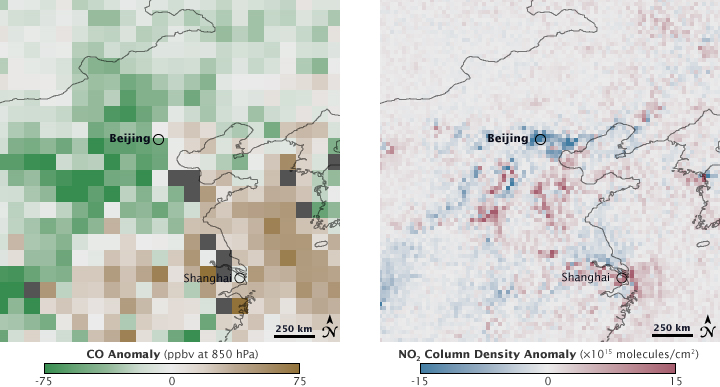


Chinese officials took extreme measures to improve Beijing’s air quality for the 2008 summer Olympic games. Factories were closed and traffic was restricted for two months. Did the restrictions make a difference? According to newly released research conducted by NASA researchers, they did. In August and September 2008, concentrations of carbon monoxide and nitrogen dioxide—pollutants released when fossil fuels are burned in cars, trucks, and power plants—fell dramatically over Beijing. The difference is illustrated in this pair of images.
The left image shows the change in carbon monoxide concentrations over the North China Plain as observed by the Measurements of Pollution in the Troposphere (MOPITT) sensor on NASA’s Terra satellite in August 2008. Areas that are green indicate a decrease in carbon monoxide compared to average values observed during the month of August in 2005, 2006, and 2007. Brown areas show where carbon monoxide concentrations were higher than average. Unlike a ground-based sensor, which records the make-up of the air immediately around it, the satellite sensor measures wide swaths of the atmosphere at a time. In this case, each square represents an area about 100 kilometers across.
Clearly, carbon monoxide concentrations decreased most in the area immediately around Beijing. According to the researchers, led by atmospheric scientist Jacquelyn Witte, carbon monoxide concentrations over Beijing decreased by 20 percent. A drop in carbon monoxide would decrease smog formation and improve human health. Carbon monoxide affects people by limiting the amount of oxygen the blood can carry to organs like the heart and brain.
Nitrogen dioxide concentrations fell by 50 percent, as shown in the image on the right. The image was made with data collected by the Ozone Monitoring Instrument (OMI) on the Aura satellite. The image compares average nitrogen dioxide concentrations observed in August 2008 to the average value observed in August 2005, 2006, and 2007. Higher-than-average concentrations are red, while lower concentrations are blue. The squares in this image measure approximately 25 kilometers across. Again, the drop in nitrogen dioxide concentrations is centered around Beijing, where restrictions were greatest.
The decrease in nitrogen dioxide concentrations likely also contributed to brighter skies. Nitrogen dioxide is the reddish brown haze that often hangs over a city. Noxious on its own, the gas is also a precursor to ground-level ozone, which is the primary constituent of smog and causes respiratory problems.
The research shows how satellite measurements of pollutants can help scientists find more accurate ways to monitor the effectiveness of efforts to reduce emissions, says Kenneth Pickering, a researcher who collaborated on the project. The research was presented at the conference of the American Geophysical Union on December 16, 2008. To read more, see New satellite data reveal the impact of Olympic pollution controls on the NASA web page.
NASA image created by Jesse Allen, using MOPITT CO data provided by the National Center for Atmospheric Research (NCAR) and the University of Toronto MOPITT Teams and Aura OMI data provided by the Aura OMI science team. Caption by Holli Riebeek.